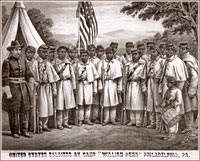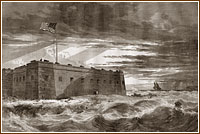CAMDEN'S HISTORIC BUTLER CEMETERY
Burial Ground for Local African-American Civil War Soldiers
By Hoag Levins


CAMDEN, N.J. -- Butler Cemetery, located at Ferry Avenue and Charles Street, is one of this city's most important African-American historical sites. Established in the 1800s by Dempsey Daniel Butler, it is the resting place of local U.S. Colored Troop veterans of the Civil War as well as other African Americans. Mr. Dempsey's tombstone (above, left) is the centerpiece of the graveyard. Above, right, is the stone of Civil War veteran James Hardcastle, who served in Co. C, 25th Regiment of the U.S. Colored Troops. He is typical of the Civil War veterans buried here.
Camp William Penn
Union Army records show that in January of 1864, the 24-year-old Hardcastle enlisted in the U.S. Colored Troops and went for training at Camp William Penn outside Philadelphia. He was 5' 4" tall and was born in Kent County, Delaware, At the time of his enlistement, was free and working as a laborer.
Camp William Penn, in what is now Cheltenham Township, was the Union Army's largest U.S. training facility for African-American troops.
Hardcastle became an infantryman in the newly-formed 25th Regiment, a unit that

|
| The USCT's 25th Regiment is featured on one of the Civil War's most popular recruitment posters. | literally became the "poster child" for the nation's newly organized black troop regiments. A large graphic broadside featuring members of the 25th was created that year and became one of the northern army's most popular and widely circulated recruitment posters.
The 25th Regiment's new flag spoke of the high emotion and epochal significance black troops attached to their activities. It was emblazoned with the image of a black man stepping out of ankle chains to seize hold of a musket being offered him by the white-robed Goddess of Liberty.
Fought in the Deep South
After its training, the 25th regiment was shipped into the deep

|
| The 25th Regiment served at Union-held coastal facilities in the deep south, including Fort Pickens in Pensacola, Fla. The fort was key to choking off supplies to inland Confederate forces. | south at the height of war. There it served throughout Louisiana and Florida along the coastal facilities and fortifications whose control was crucial to the outcome of the conflict.
An indication of the hardships that Hardcastle's unit endured in the swampy areas of the Gulf coast can be found in his own medical record. He suffered both scurvy and malaria during his tour of duty there.
Hardcastle was mustered out of service in December of 1865. He died in Camden at the age of 71 in 1910 and was buried in Butler Cemetery. Civil War pension records indicate that shortly after his death his first wife, Amelia, who lived in Delaware, and his second wife, Charlotte, who lived in Camden, both filed for his Civil War widow's pension.
Dempsey Daniel Butler
Founder of Butler Cemetery
Dempsey Daniel Butler was born in 1820 in Virginia. He first arrived in the City of Camden in the 1840s, where he opened a general store on Kaighns Avenue. As his business prospered, he invested in real estate, built boarding houses, a Masonic hall, churches, a cemetery and schools for black Camden residents.
A prominent philanthropist, Mr. Butler used his wealth to further the cause of civil rights in Camden at a time when South Jersey citizens were hostile to the idea of civil rights for former slaves and the city was in the firm grip of Jim Crow. In the 1870s, blacks who wandered into white neighborhoods were driven off and, on several occasions, lynch mobs were formed, leading Mr. Butler to despair, "If I have any rights which a white man is bound to respect, I scarcely know what they are." (1)
During his lifetime, Mr. Butler:
- Was an abolitionist and ardent supporter of the Underground Railroad.
- Established the Knights Point area of Camden (now called Kaighnsville) for Freed Slaves and "colored" Camden residents; an 1830s map shows a garden in Kaighnsville set aside "for the people of color."
- Established Butler Cemetery at Ferry Avnue and Charles Street in Camden to provide a resting place for local African-American veterans of the Civil War.
- Endowed the Cooper Hospital, Philadelphia Hospital, and the Camden School for Colored and Destitute Children with generous gifts of money and/or land.
- Endowed Rising Sun Lodge No.1 with $3000 and land for construction of Butler Masonic Hall, formerly located at Kaighn Ave. and Ann St. (now
called Maurice St.), and served as Past Grand Master for the New Jersey State Chapter of Prince Hall Masons.
- Owned Butler Hotel in Atlantic City, where he provided employment for freed slaves and colored residents of Southern New Jersey.
By the time of his death in 1900, Mr. Butler's wealth was estimated at more than $100,000 in monies and assets which, at that time, equaled the holdings of the various banks in the City of Camden and made him the wealthiest African American in Camden County.
Both Dempsey Butler and his wife, Eliza, are buried in Butler Cemetery.
~ ~ ~
(1). Our Town: Race, Housing and the Soul of Suburbia; Kirp, Dwyer and Rosenthal; c. 1995
All Rights Reserved © 2007-2009, Hoag Levins
HoagL@earthlink.net
About this Web site
|









